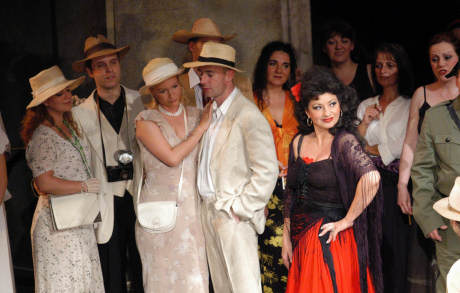Other Links
Editorial Board
-
Editor - Bill Kenny
-
Deputy Editor - Bob Briggs
Founder - Len Mullenger
Google Site Search
SEEN AND HEARD
INTERNATIONAL OPERA REVIEW
Bizet, Carmen: Soloists, Chorus and Orchestra of Hungarian State Opera, Conductor: Héja Domonkos, Budapest 24.5.2009 (BM)

Attending a performance at Budapest Opera House is a special occasion in itself. Inaugurated in 1884, its neo-classical to neo-Renaissance design is the work of Miklós Ybl, the leading Hungarian architect of the 19th century. Statues of no fewer than 16 great composers, from Monteverdi to Moniuszko, guard the building like sentries arranged in a semi-circle around the imposing second story balustrade. It is a museum in its own right, bursting at the seams with works of art and reminders of significant moments in the history of music – Gustav Mahler began his career as a conductor here, for example - and those unable to purchase a ticket to one of the opera house’s sold-out performances would do well to take advantage of the daily guided tours.
The production of Carmen showing in Budapest at present may not be new (the premiere was back in May 2000), but it does full justice to this opera house’s grand tradition. Director Miklós Szinetár’s concept is to show us how we tend to content ourselves with a gratifying, yet voyeuristic outlook on this fiery, passionate tale from Spain, and he does so by cleverly introducing cameo roles for a photographer and a group of tourists (from Britain perhaps?) The plot developing on stage is a vehicle for professional gain for the early 20th century paparazzo, while resulting in a great deal of foolish gawking on the part of the sightseers. The wistful set and costumes by Attila Csikós and Renate Schmitzer were designed with great attention to detail, but Jenõ Lõcsei’s choreography was perhaps somewhat less resourceful, resulting in much standing around and ballet numbers which were on the dull side.
Eva Pánczél in the title role had some audible pitch problems during the first act, but fortunately she succeeded in overcoming them admirably, allowing her to flaunt her full mezzo as befitted her character during the better part of her performance. Her Don José was Attila Wendler, who provided some of the evening’s most worthwhile moments in terms of timbre and expressive phrasing, and gave himself to his role completely during the final scene (not necessarily to be expected after he and Pánczél spent the previous three acts virtually singing at each other). András Káldi Kiss’ Escamillo was slightly lackluster in voice, though not in appearance, and in this respect the opposite of Carmen’s discarded lover; Tünde Frankó deserves special mention for a resplendent Micaëla.
The orchestra under Héja Domonkos and the chorus coached by Máté Szabó Sipos were outstanding and always precisely on the mark, conveying what we tourists perceive as the Spanish flair of Bizet’s score with utter commitment. Gyöngyvér Gupcsó’s Children’s Chorus was the strongest I have ever heard perform this work, and they obviously took pleasure in practicing their acting skills as well.
What deserves the most praise, however, is the collective achievement of the artists involved in this production as an ensemble of performers; all entirely in tune with each other and dedicated to making their performance a success, not simply a backdrop against which the soloists could show off. In view of all this, it felt like an additional windfall that each and every one of the singers’ diction was first-rate, so that it mattered little that there were no English surtitles.
Well done – it is no wonder that tickets to the opera in Budapest are so often hard to come by!
Bettina Mara
Picture © Vera Éder
Back to Top
Cumulative Index Page
